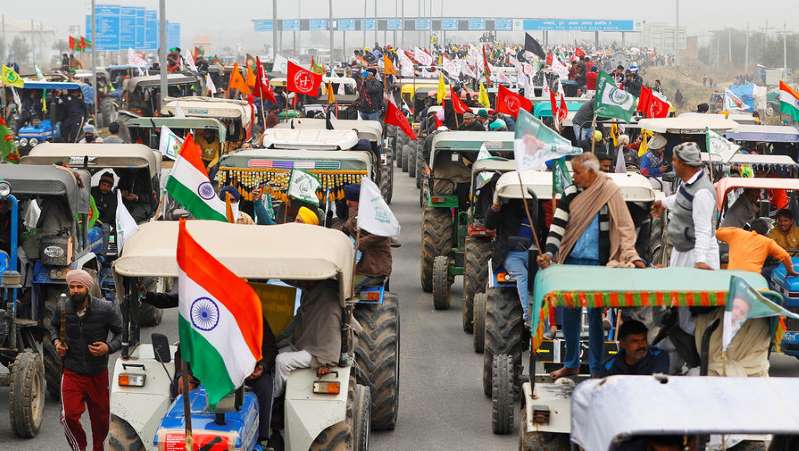
Mass protests overwhelmed the capital of India over new laws
A rally against agricultural reforms in India escalated into massive clashes between local farmers and police on Republic Day, which was celebrated on January 26. Although the tractor rally around New Delhi was initially agreed with the authorities and had to go along certain routes, the locals broke the agreement, broke through the police barriers in the central streets of the capital and seized one of the historic buildings in the heart of the city.
One of the farmers was killed in the protests, New Delhi police said.
The footage spread over the network shows how a blue tractor at high speed breaks into the fences set by the police, turns over several times and freezes on the roof. Driving, 26-year-old Navdeep Singh Hundal, who came from the state of Uttarakhand in northern India, suffered fatal injuries.
However, even the loss of a comrade-in-arms did not pacify the protesters, who continued to move to the city center. As a result, they took over the Red Fort – a historic building listed as a UNESCO heritage – and raised their flag over it. After a few hours, all the outsiders were removed from the fort, but the situation was still tense.
“We asked farmers to follow a pre-approved route, but some of them broke police barricades and attacked police officers. We appeal to the farmers' unions with a request to help keep the peace in the country, ”the police called from the TV screens, they were broadcast by the ANI agency.
On the day of the most violent clashes in some areas of the capital, mobile Internet was turned off and metro stations were closed. Furious crowds marched through the city streets with sticks and iron bars, which they periodically beat up police officers – more than 80 officers were seriously injured, according to the authorities. Security officials dispersed the protesters with bamboo sticks and tear gas.
Workers from other industries also decided to express their solidarity with farmers – who, by the way, make up about 40% of the country's total population. “We came here to support the farmers! Because they don't get what they want, “said Megha Mallik, an employee of one of the capital's offices, who walked along with hundreds of other protesters to a cricket field in downtown Mumbai. In total, the protest received the support of about 3 million people.
Protests in India began on November 26 – but then they took place on the periphery and practically did not affect the country's capital. Farmers from six Indian states – Punjab, Uttar Pradesh, Haryana, Uttarakhand, Rajasthan and Kerala – were the first to oppose three new agricultural laws, which they called their “death sentence.” The first step was a one-day strike by a group of 10 leading Indian unions.
“We are ready for an all-India strike on November 26. We expect that this time more than 250 million workers will take part in the strike,” the trade unions announced the event.
In early December, they also threatened to block all roads leading to the Indian capital, NDTV reported. “The government agrees with our demands on the minimum price, electricity and fines for burning stubble, but we will not stop until the laws are lifted,” Singh Ajnal, head of one of the protest-backing organizations, told Satnam TV.
According to the government's plan, the new laws were supposed to eliminate intermediation and increase farmers' incomes. The latter, in particular, were able to sell their products on the commercial market anywhere in the country.
Nevertheless, the protesters see a different outcome of the adoption of laws – in their opinion, reforms give more power to dealers and threaten the independence of peasant farms.
In order to resolve the situation, the government held about 11 meetings with the indignant population, but no compromise was reached.
“We do not accept any amendments to the laws, we want to completely repeal them. If the government demonstrates decisiveness, so will the farmers. These laws should be withdrawn,” Rakesh Tikait, a spokesman for the Indian Union of Farmers, told reporters.
According to the indignant farmers themselves, they do not intend to stop there – the next step should be a march to parliament. “Dispelling a peaceful protest only makes the government more trouble. This will not end there. Our movement will only gain momentum, ”said the leader of one of the farmers' unions, Kavalpreet Singh Pannu.

